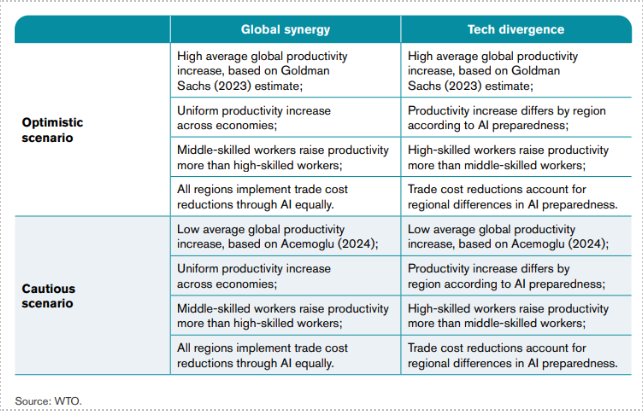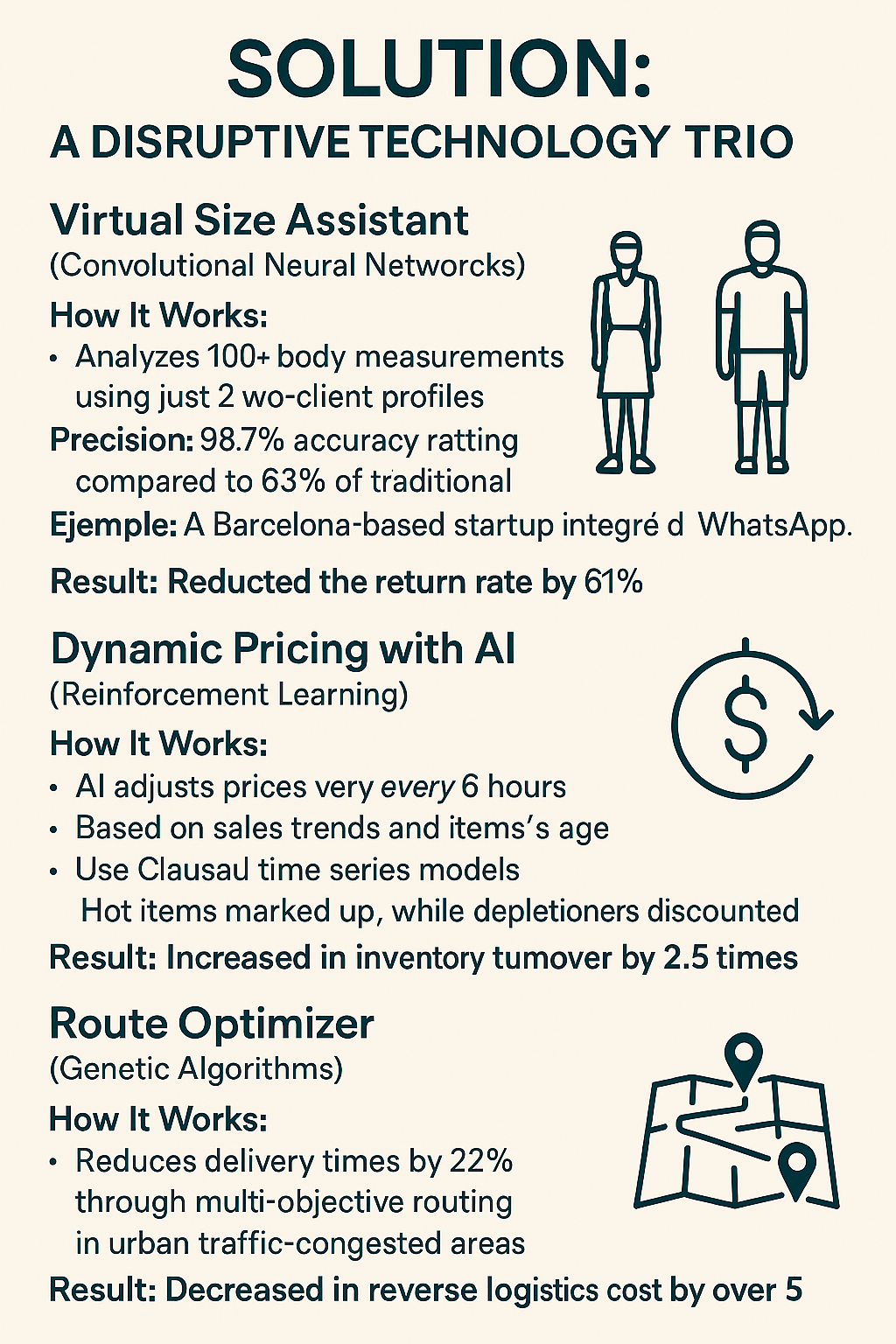
AI in International Trade
To conclude this first quarter we would like to dedicate a special publication in our ‘International Trade’ section to explore how Artificial Intelligence (AI) is redefining the international strategies of exporting SMEs.
Why AI is the Big Paradigm Change in World Trade
In the last two years, we have witnessed an unprecedented transformation in global value chains. AI is no longer a futuristic concept, but the main driver of competitiveness in international trade.
According to the latest WTO study (2024): ‘The Impact of AI on International Trade’, this is the biggest technological disruption since the invention of the freight container in the 1950s. In fact, according to data from the International Trade Observatory (2024), 78.3% of exporting SMEs that have adopted AI-based solutions experience improvements of more than 25% in their international competitiveness.
‘78.3% of exporting SMEs that adopt AI processes improve their competitiveness by 25%’.
What makes this revolution unique? Three key factors:
- Adoption speed: While e-commerce took 20 years to transform markets, AI is achieving similar impacts in just 36 months.
- Democratisation effect: Tools that used to cost millions are now available to SMEs thanks to chatbox models such as ChatGPT and cloud solutions.
- Cross-cutting impact: From customs to marketing, no link in the trade chain escapes this transformation.
In this article we will go into more detail:
- The WTO Report on AI and Trade
- AI as a logistical ally
- Example cases of AI application in different economic sectors
Key Findings of the WTO Report on AI and World Trade (2024)
The report ‘The Impact of AI on International Trade’ is the most comprehensive analysis to date, with data from 184 countries and more than 5,000 companies.
The main findings of this report are as follows:
- Projections of International Trade Growth through AI: Two Different Scenarios
The WTO's simulation model proposes two scenarios for 2040:
Optimistic Scenario
It is based on the assumption of coordinated adoption of AI processes by all countries in international trade. This would lead to the following results:
- 14% growth in world trade by 2024 (equivalent to an additional $2.8 trillion)
- Digital services would lead world trade with 18% growth.
- Developing countries would reduce their trade costs by up to 22%.
Pessimistic Scenario:
It is based on the assumption of the existence of technological fragmentation in which the development of AI is different in certain areas or countries. This would lead to the following results:
- Only 7% growth in world trade by 2040.
- 75% of the benefits would be concentrated in 5 economies (US, China, EU, Japan and South Korea).
- Increasing digital divide (only 1 in 4 SMEs in emerging countries would adopt AI processes)

- Reconfiguring Global Value Chains
The report clearly points out how AI is altering global value chains and thus disrupting traditional patterns of trade, through:
Appearance of new comparative advantages, for example:
- Cheap renewable energy countries like Chile and Morocco attract data centres
- Appearance of economies with specialised talent such as India, which dominate AI services
Appearance of critical dependencies, with special mention to the existing dependency on microchips and soil, due to the fact that:
- 95% of advanced chips depend on TSMC (Taiwan) and Samsung. As we pointed out in our blog published in the Commercial Geopolitics section: ‘The Importance of the South China Sea and the Dominance of Microchips’.

- Emerging Barriers
The study also identifies 3 main threats to the development of AI processes in international trade:
- Regulatory fragmentation: In 2024 there were 186 different AI regulations compared to only 22 regulations in 2018. All this leads to a compliance cost for SMEs of $142,000 on average.
- Technological asymmetries: Because 89% of AI patents are from the US (43%) and China (46%), while Sub-Saharan Africa accounts for only 0.3% of global investment in AI.
- Climate impact: As training an advanced model emits 284 tonnes of CO₂, equivalent to 25 New York-London flights.
AI as a revolutionary logistical ally in customs processes
As mentioned above, one of the areas where AI is having the greatest impact is in international logistics operations, especially in customs processes.
A recent study published by the European Commission called "European Commission Report on Customs 4.0″ describes very well how artificial intelligence is revolutionising customs processes; the main areas where AI is having the greatest impact:
- Tariff classification processes, in which thanks to the development of AI, a reduction of more than 72% of contingencies is being achieved; this leads to tariff classification models with more than 93% accuracy.
This is one of the main areas where AI is bringing about a significant change in the structure of world trade. Such is its importance that the next publication in this section on International Trade will be devoted exclusively to developing the latest developments in this field through practical examples.
- Computerised documentation, in which different AI processes are being applied to achieve a reduction of more than 85% of the errors that were traditionally made, resulting in a reduction of more than 68% in the processing time of customs documentation.
- Regulatory compliance, where due to the AI programmes developed, a 64% reduction in customs penalties is being achieved, resulting in a 90% increase in the coverage of all processes.

High Return on Investment in AI
One of the least talked about, but most important issues for both investors and the development of AI technologies in general is the return on investment, and above all answering the eternal question of whether it is worth investing in AI.
To discuss this issue, we have analysed a report by PwC entitled: ‘Sizing the prize: AI's trillion-dollar opportunity’. This report analyses, among other issues, the return on investment in AI by sector, and points out very strong data and conclusions, even taking into account that, as it could not be otherwise, investment in AI and its return varies by sector.
In fact, as we can see in the graph, the manufacturing sector stands out with the highest returns among all the sectors analysed; indicating that there is strong potential for AI solutions to drive efficiency and profitability in the manufacturing industry. We are talking about leading companies in this sector achieving a 5.1x return on investment (ROI) in just 36 months.
Three other sectors also stand out in which the return on investment is between 3 and 5 times the investment. Thus, we can highlight the services sector with an average ROI of 3.1 times scaling up to 4.6 times in advanced implementations, the commerce sector with an ROI of 3.5 times and the agribusiness sector with an ROI of 2.8 times.
Furthermore, as we can see from the graph, the differences between sector averages and top performers suggest that there is significant room for improvement within each sector to achieve higher returns through better implementation and utilisation of AI solutions.


To the question if it is worth investing in AI, the answer is clear: It is not that it is worth investing, it is that for any exporting company it is essential to invest in AI and even more so if you are an exporting SME.
Example cases of AI application in different sectors of internationalisation.
As a continuation of the analysis of the advantages and opportunities that AI provides to exporting SMEs, we offer several success stories of AI application in three of the main sectors of world trade: agri-food, textiles and automotive.
Agri-food sector: Wine Industry

Current problems in the wine sector
The wine sector, especially in appellations of origin, is facing critical challenges that mainly limit its international competitiveness:
- An international gross margin stagnating at 18%, well below the sector's potential.
- A high number of order errors affecting 22% of operations, generating logistics costs and loss of customer confidence.
- Long customs delays (5.3 days on average) which hinder the timely delivery of goods.
Solution: Demand-driven AI process development, Quality Control and Document Management
The results of this AI implementation process have produced spectacular results that have enabled the wine sector to make a significant leap in competitiveness in just 12 months.

"In international trade, AI is like a vehicle's navigation system: Without it, the road is longer, more expensive and full of unforeseen events. With it, every kilometre (and every shipment) is optimised to the maximum".
Premium Textile Sector

Another sector that we want to analyse for its importance is the textile sector, where there is a real problem of losses of millions in the premium sector, mainly due to three major obstacles faced by these brands:
- High number of returns: 27% of products purchased are returned mainly due to size errors.
- Stagnant inventory: With only 2 rotations per year, many collections do not reach the public and end up dying in the warehouses.
- Unsustainable reverse logistics: In which almost 9% of sales are consumed in handling returns.
In other words, we have a business model where every 4 garments sold, 1 ends up back in stock.
Solución:
Establishment of an AI process based on the development of a Disruptive Technology Trio.
"Nowadays, fashion is no longer
art + crafts...
is art + algorithms".

Automotive Components

The automotive sector, and mainly SMEs, faces three major problems:
- High logistics inefficiencies, linked to non-optimised routes, transport cost overruns and manual inventory management. As a result, SMEs in the automotive sector lose up to 38 % of their margin on these logistical inefficiencies.
- Customs delays: 28% of operations suffer delays due to errors in documentation or lack of knowledge of regulations, resulting in an average time of 5-7 days in customs with the additional storage costs that this entails.
- High documentation processes: resulting in almost 33% of shipments having to be resubmitted due to incorrect documentation.

"En el comercio internacional,
la IA es como el sistema de navegación de un vehículo:
Sin ella, el camino es más largo, costoso y lleno de imprevistos.
Con ella, cada kilómetro (y cada envío) se optimiza al máximo."
Conclusion: AI, an Indispensable Pillar of Internationalisation
SMEs that want to compete successfully in global markets cannot afford to ignore Artificial Intelligence.
The data is irrefutable: AI not only optimises costs and processes, but also opens doors to new business opportunities, improves regulatory compliance and increases customer satisfaction with very high returns on investment.
Integrating AI into the internationalisation plan is no longer an option, but a strategic necessity. From logistics to marketing to customs management, AI-based tools are proving to be the differentiator that separates companies that grow from those that fall behind.
Internationalisation is no longer limited to traditional markets.
With AI as an ally, SMEs can explore new horizons with greater agility and less risk, ensuring a competitive and sustainable global presence.
And remember now more than ever... THERE IS LIFE BEYOND TURKEY!

Just tried Sprunki Incredibox and it’s a fresh twist on music mixing! Love the new beats and visuals-they really bring creativity to life. Super fun for all skill levels!
Sprunki Incredibox brings a fresh twist to music-mixing fun with new beats and visuals. It’s a must-try for fans of creative gameplay. Check it out at Spunky Games.